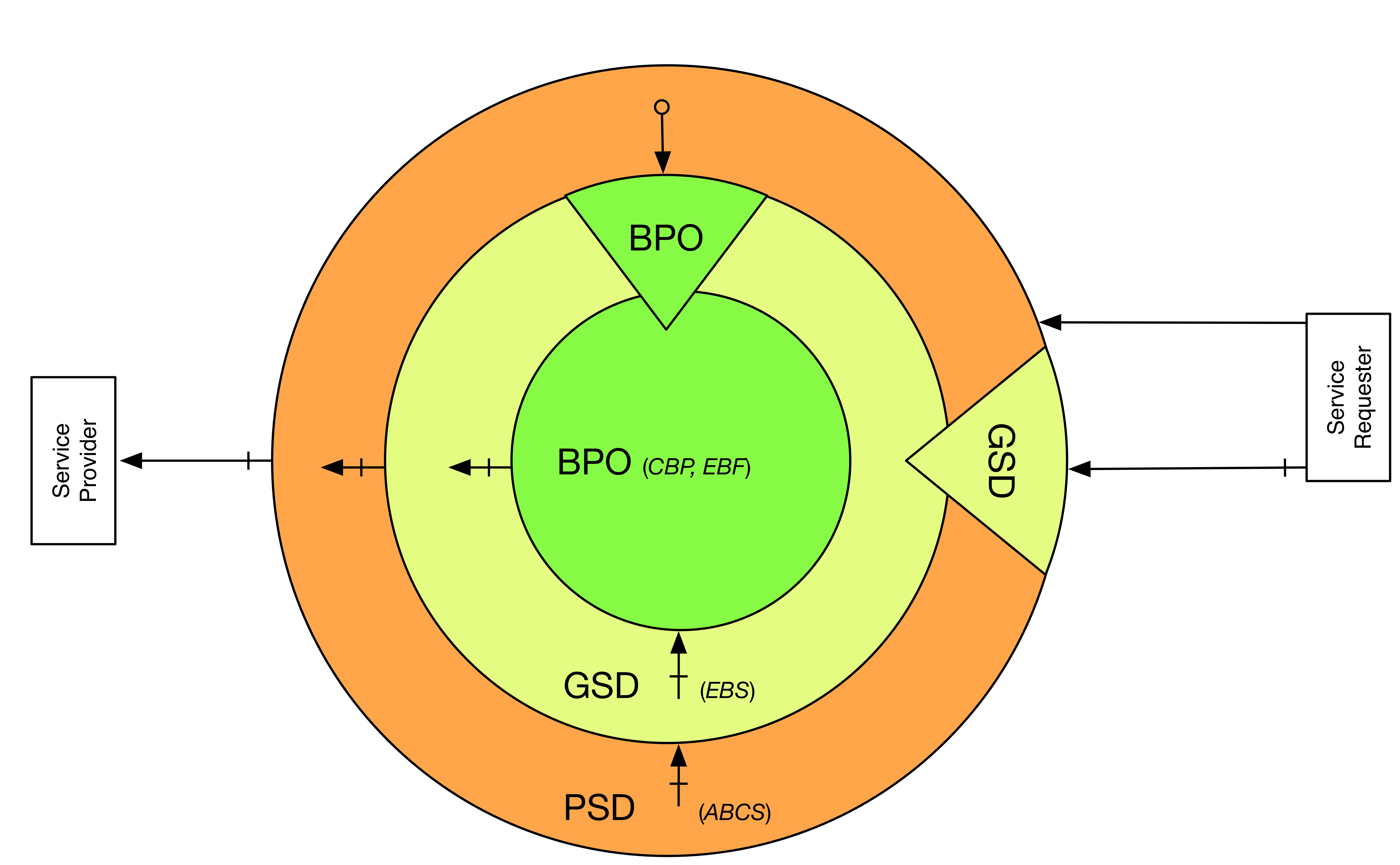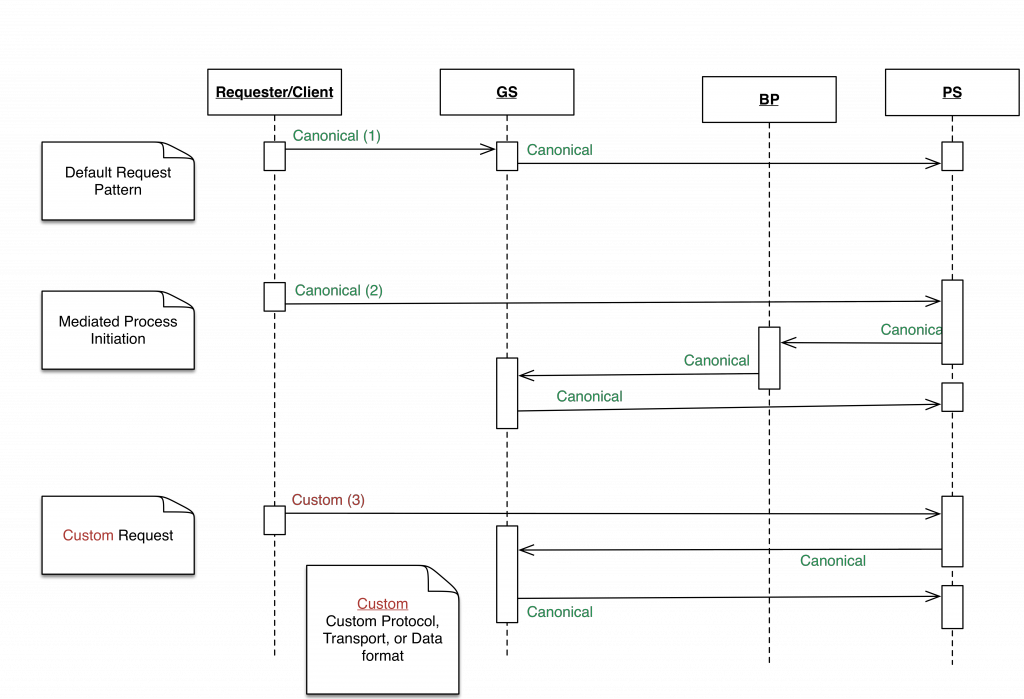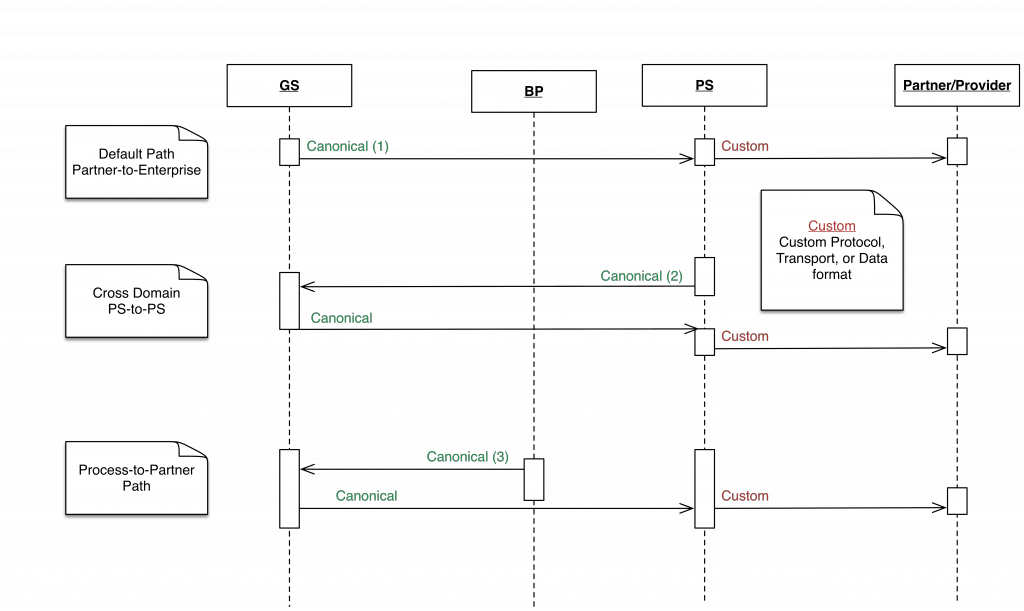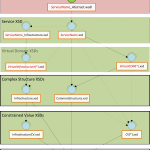There are many ways to conceptualise SOA services within an enterprise, and there are many ways to organise the implementation units. Here is an illustration of the SOA services architecture of a recent client. I think it is a tidy model, but as in my recent post on governance, “Rhema Bytes: Governance a Rope that Holds Development to Architecture?”, one must bear in mind that a model is only as good as its implementation. Furthermore, every model needs evolution and in the medium term, managing constructive change can be difficult, or disastrous. The devil is in the detail.
What is described here is a high-level view of a canonicalisation context, and it is very similar to Oracle’s AIA. The basic idea is simple. Having disparate clients and partners, a business needs to expose a platform of services, with the minimal set of technologies, components and patterns. The aim is to deliver the fewest generic patterns required to manage the boundary, and the implementation of internal functions. Whatever the design or model, every day use will throw up issues that require consideration. Not everything will fit any model. There will be calls for a dispensation for non-compliance, temporary exemption and technical debt; or changes to the model where inadequacies or incongruences are discovered.
It is useful to reference the post, “Rhema Bytes: The Business to SOA Nexus”, where the discussion was on core services that a business offers, and the automated processes that realise those services. To recap, the post identified business processes as a key focus of IT, and their implementation as the automation of business services. These automated business processes (BP) are the primary targets for the clients of the eBusiness. Most other services will normally be subsumed within the lifecycle of these business processes – with some exceptions. The BP is at the top level of the abstraction model under discussion here.
The diagram below provides an overview, with some AIA mappings:

The genres of service shown in the diagram are described below:
BP – Business Processes (composite, long-running, process-centric, use cases)
Facilitates integration with core services and business, but is never accessed directly
Groupings: Process, Utility
AIA Equivalent: CBP, EBF
GS – Generic Services (composite or atomic, use cases)
Primary path into the enterprise for partners and integrators
This is an intermediation layer that decouples the enterprise from external systems
Types: Atomic, Composite
Groupings: Process, Data, Utility
AIA Equivalent: EBS, EBF
PS – Primitive Services (atomic use cases)
The only route outwards from enterprise
Secondary path into the enterprise – in addition to the GS
Types: Wrapper (BP), Adapter (GS), Mediator (partners), Facade (internal apps)
Groupings: Process, Data, Utility
AIA Equivalent: ABCS
BPs are the typical target for end users, especially human clients. However, there are exceptions, e.g. utility services, where a simple or business-agnostic use case delivers some value. Another example is for system integrators that compose existing services into new mashups. In such scenarios, it would be superfluous to add the overhead of a process. A BP must not be directly accessed by a partner. That would represent an unacceptable level of coupling between the enterprise and partner systems. Instead, BPs are accessed through an intermediary service; the details of that kind will follow in short order.
…
Partners that are involved in the value/supply chain may find it expedient to integrate directly with lower level services. In this case, the generic services (GS). This à la carte access is a complement to the prix fixe integration at the BP layer that is available to B2C and other clients. This option is of particular benefit where there are incongruences between internal order of tasks in equivalent processes.
Generic services (GS) are the default intermediation layer. GSs aggregate lower level services into functional components (data/process/utility), and serve as a facade for all underlying service units. GSs stand between the enterprise and partner systems and also decouple services internally. A GS will provide services to BPs and peer GSs from other groupings. A GS can be atomic or composite, depending on the number of lower level services that are involved in its value chain.
At the lowest level are the primitive services (PS). These are the gateway to the outside world. There is only one way out for requests emanating from the enterprise, and that is through the PS. The PS is the canonicalisation frontier for the enterprise; all, or most, mediation occurs here, be it data, protocol, security, transport, etc. Like the ABCS in AIA, PSs will convert from an application-specific schema to the canonical schema using custom EBM/EBO equivalents. The PS is also similar to the ABCS in that it normally routes requests to other services through the GS above it.
Partner (client) systems do not normally integrate inwards via a PS. Instead requests should are routed to the canonical GS layer. In most cases, this rule is good, but there are exceptions, due to significant differences between the types of PSs:
PSM – the default; this is a general purpose mediator to a partner system
PSF – a facade; this is wrapper around an internally developed application
PSA – an adapter; this facilitates a partner to access a service in a non-standard way
PSW – a wrapper; this simply puts a thin, non-active, decoupling layer over a BP
While the great majority of integration scenarios will be covered by the PSM variant, the other three break the rule. Either because they introduce a secondary PS layer (PS-to-PS) or that they facilitate access to the enterprise directly – (PS-to-BP), (PS-to-App).
The model is similar to Oracle’s AIA, but there are a few differences. Incoming requests go through a generic interface, rather than an application-specific interface, as this cuts down the number of services – see exceptions above. Also, a request to a BP only goes through canonicalisation in a PS before it is directly passed on to the BP. Another difference is in the schema design; this model uses lightweight, flatter EBOs and very strict EBMs that constrain data domains. The end result though is the same, although each approach has its strengths and weaknesses.
These service genres have clear functions which are not elaborated here, and there are preferred technologies for realising each one. The characteristics of the interface of each genre and the interaction patterns between genres are also largely predetermined.
In another article, “Rhema Bytes: A Factory Approach to Service Engineering”, the velocity and efficiency gains of automation is examined. This model is useful as a basis for creating templates or a factory for concrete building blocks. Each template is preconfigured with defaults for all the functional aspects of its type/class, and can be easily configured by developers to fit specific use cases. This has great value, especially for dispersed teams; it gets the horse to the river, quickly and easily. Of course the next challenge is to get it to drink 🙂 But that is a tale for another day!
—
Oyewole, Olanrewaju J (Mr.)
Internet Technologies Ltd.
lanre@net-technologies.com
www.net-technologies.com
Mobile: +44 [0] 793 920 3120





Interesting blog post; shows that AIA is not unique after all.
This form of abstraction is dependent upon how much of the service logic is exposed as service capabilities. An example would be of a class whereby some of its methods are private while others are public. A class would only expose those methods as public that it deems to be important to its objects, any helper methods that are not relevant to the objects are kept hidden.